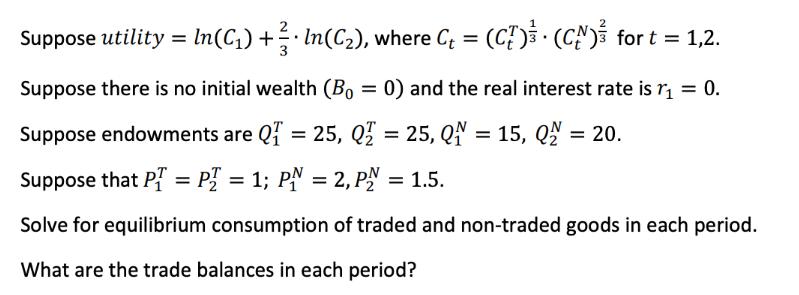Question
Suppose utility = In(C) + In(C), where C = (C) (C) for t = 1,2. Suppose there is no initial wealth (B = 0)

Suppose utility = In(C) + In(C), where C = (C) (C) for t = 1,2. Suppose there is no initial wealth (B = 0) and the real interest rate is 1 = 0. = 25, Q = 15, Q = 20. Suppose endowments are Q = 25, Q = 1.5. Suppose that P = P = 1; PN = 2, P Solve for equilibrium consumption of traded and non-traded goods in each period. What are the trade balances in each period?
Step by Step Solution
There are 3 Steps involved in it
Step: 1
To solve for the equilibrium consumption of traded and nontraded goods in each period and calculate ...
Get Instant Access to Expert-Tailored Solutions
See step-by-step solutions with expert insights and AI powered tools for academic success
Step: 2

Step: 3

Ace Your Homework with AI
Get the answers you need in no time with our AI-driven, step-by-step assistance
Get StartedRecommended Textbook for
Microeconomics An Intuitive Approach with Calculus
Authors: Thomas Nechyba
1st edition
538453257, 978-0538453257
Students also viewed these Economics questions
Question
Answered: 1 week ago
Question
Answered: 1 week ago
Question
Answered: 1 week ago
Question
Answered: 1 week ago
Question
Answered: 1 week ago
Question
Answered: 1 week ago
Question
Answered: 1 week ago
Question
Answered: 1 week ago
Question
Answered: 1 week ago
Question
Answered: 1 week ago
Question
Answered: 1 week ago
Question
Answered: 1 week ago
Question
Answered: 1 week ago
Question
Answered: 1 week ago
Question
Answered: 1 week ago
Question
Answered: 1 week ago
Question
Answered: 1 week ago
Question
Answered: 1 week ago
Question
Answered: 1 week ago
Question
Answered: 1 week ago
Question
Answered: 1 week ago
Question
Answered: 1 week ago
View Answer in SolutionInn App



